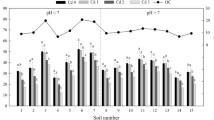Abstract
The technique of diffusion gradient in thin films (DGT) for assessing bioavailable metals has not been tested under field conditions. We assessed the relationships of DGT- and cation exchange resin-membrane-measured concentrations of Cd, Cu, Pb, and Zn with plant uptake of the metals under greenhouse and field conditions. In the greenhouse, the effective concentrations of Cu, Pb, and Zn by DGT correlated significantly with uptake by sorghum (Sorghum bicolor), but cation exchange resin-membrane-measured concentrations of Cd, Pb, and Zn did not correlate with sorghum uptake. In the field, the DGT-measured concentrations of Cd, Pb, and Zn were not linearly related to uptake Cd, Pb, and Zn by lettuce (Lactuca sativa) except for Cu uptake (r = 0.87, p < 0.05). Similarly, it was only the resin-membrane-extractable Pb that correlated with Pb uptake by lettuce (r = 0.77; p < 0.05). However, fitting non-linear regression models improved the plant metal uptake predictions by DGT-measured bioavailable Cd, Cu, Pb, and Zn under field conditions. In conclusion, the DGT technique was fairly predictive of bioavailability in the greenhouse, but not in the field.
Similar content being viewed by others
References
Agbenin, J. O., Danko, M., & Welp, G. (2009). Soil and vegetable compositional relationships of eight potentially toxic metals in urban garden fields from northern Nigeria. Journal of the Science of Food and Agriculture, 89, 49–54.
Almas, A. R., Lombuds, P., Sogun, T. A., & Mulder, J. (2006). Speciation of Cd and Zn in contaminated soils assessed by DGT-DIFS and WHAM Model VI in relation to plant uptake by spinach and ryegrass. Chemosphere, 62, 1647–1655.
Barber, S. A. (1995). Soil nutrient bioavailability. A mechanistic approach. New York: Wiley.
Buzier, R., Tusseau-Vuillemin, M. H., & Mouchel, J. M. (2006). Evaluation of DGT as a metal speciation tool in wastewater. Science of the Total Environment, 358, 277–285.
Cattani, I., Fragoulis, G., Boccelli, R., & Capri, E. (2006). Copper bioavailability in the rhizosphere of maize (Zea mays L) grown in two Italian soils. Chemosphere, 64, 1972–1979.
Gee, B. W., & Bauder, J. W. (1982). Methods of soil analysis, Part 1, Physical and mineralogical methods (2nd ed., pp. 383–411). In A. Klute (Ed.), ASA and SSSA, Madison, Wisconsin, USA, 1996.
Harper, M., Davison, W., Zhang, H., & Tych, W. (1998). Kinetics of metal exchange between solids and solutions in sediments and soil interpreted from DGT measured fluxes. Geochimica et Cosmochimica Acta, 62, 2757–2770.
Hooda, P. S., Zhang, H., Davison, W., & Edwards, A. C. (1999). Measuring bioavailable trace metals by diffusive gradients in thin films (DGT): Soil moisture effects on its performance in soils. European Journal of Soil Science, 50, 285–294.
Koster, M., Reijnders, L., van Oost, N. R., & Peijnenburg, W. J. G. M. (2005). Comparison of diffusive gels in thin films with conventional extraction techniques for evaluating zinc accumulation in plants and isopods. Environmental Pollution, 133, 103–116.
McGrath, S. P., Chang, A. C., Page, A. L., & Witter, E. (1994). Land application of sewage sludge. Scientific perspectives of heavy metal loading limits in Europe and the United States. Environmental Review, 2, 108–118
Nelson, D. W., & Sommers, L. E. (1982). Total carbon, organic carbon and organic matter. In A. L. Page, R. H. Miller, & D. R. Keeney (Eds.), Methods of soil analysis, Part 2, Chemical and microbiological methods (2nd ed., pp. 539–579). Madison: SSSA.
Nolan, A. L., Zhang, H., & McLaughlin, M. L. (2005). Prediction of zinc, cadmium, lead and copper availability to wheat in contaminated soil using chemical speciation, diffusive gradient in thin films, extraction and isotopic dilution techniques. Journal of Environmental Quality, 34, 496–507.
Nowack, B., Koehler, S., & Schulin, R. (2004). Use of diffusive gradient in thin films in undisturbed field soils. Environmental Science & Technology, 38, 1133–1138.
Prueβ, A. (1997). Action values for mobile (NH4NO3) trace elements in soils based on the German standard DIN 19730. In R. Prost (Ed.), Contaminated soils. proc. 3rd int. conf. on the biogeochemistry of trace elements (pp. 415–423). Paris: INRA.
Rhoades, J. D. (1982). Cation exchange capacity. In A. L. Page, R. H. Miller, & D. R. Keeney (Eds.), Methods of soil analysis, Part 2, Chemical and microbiological methods (2nd ed., pp. 149–157) Madison: SSSA.
Sauve, S., Cook N., Hendershot W. H., & McBride, M. B. (1996). Linking plant tissue concentrations and soil copper pools in urban contaminated soils. Environmental Pollution, 94, 153–157.
Sauve, S. N., Dumestre, A., McBride, M. B., & Hendershot, W. (1998). Derivation of soil quality criteria using predicted chemical speciation of Pb2 + and Cu2 + . Environmental Toxicology and Chemistry, 17, 1481–1489.
Sonmez, O., & Pierzynski, G. M. (2005). Assessment of zinc phytoavailability by diffusive gradients in thin films. Environmental Toxicology and Chemistry, 24, 934–941.
Valette, J., & Ibanga, I. J. (1984). Soil survey bulletin. Zaria: Institute for Agricultural Research, Ahmadu Bello University.
Young, S. D., Tye, A., Cartstensen, A., Resende, L., & Crout, N. (2000). Methods for determining labile cadmium and zinc in soil. European Journal of Soil Science, 51, 129–136.
Zarcinas, B. A., Cartwright, B., & Spouncer, L. R. (1983). Nitric acid digestion and multi-element analysis of plant material by inductively coupled plasma spectrometry. Communications in Soil Science and Plant Analysis, 18, 131–146.
Zeien, H., & Bruemmer, G. W. (1989). Chemische Extraktionen zur Bestimung von Schwermetallbindungsformen in Boden. Mitt. Dtsch. Bodetikundl. Gesellesch., 59/1, 505–510.
Zhang, H., & Davison, W. (1995). Performance characteristics of diffusion in thin films for the in situ measurement of trace metals in aqueous solutions. Analytical Chemistry, 67, 3391–3400.
Zhang, H., Zhao, F., Sun, B., Davison, W., & McGrath, S. P. (2001). A new method to measure effective soil concentration predicts copper availability to plants. Environmental Science & Technology, 35, 2602–2607.
Author information
Authors and Affiliations
Corresponding author
Rights and permissions
About this article
Cite this article
Agbenin, J.O., Welp, G. Bioavailability of copper, cadmium, zinc, and lead in tropical savanna soils assessed by diffusive gradient in thin films (DGT) and ion exchange resin membranes. Environ Monit Assess 184, 2275–2284 (2012). https://doi.org/10.1007/s10661-011-2116-5
Received:
Accepted:
Published:
Issue Date:
DOI: https://doi.org/10.1007/s10661-011-2116-5




